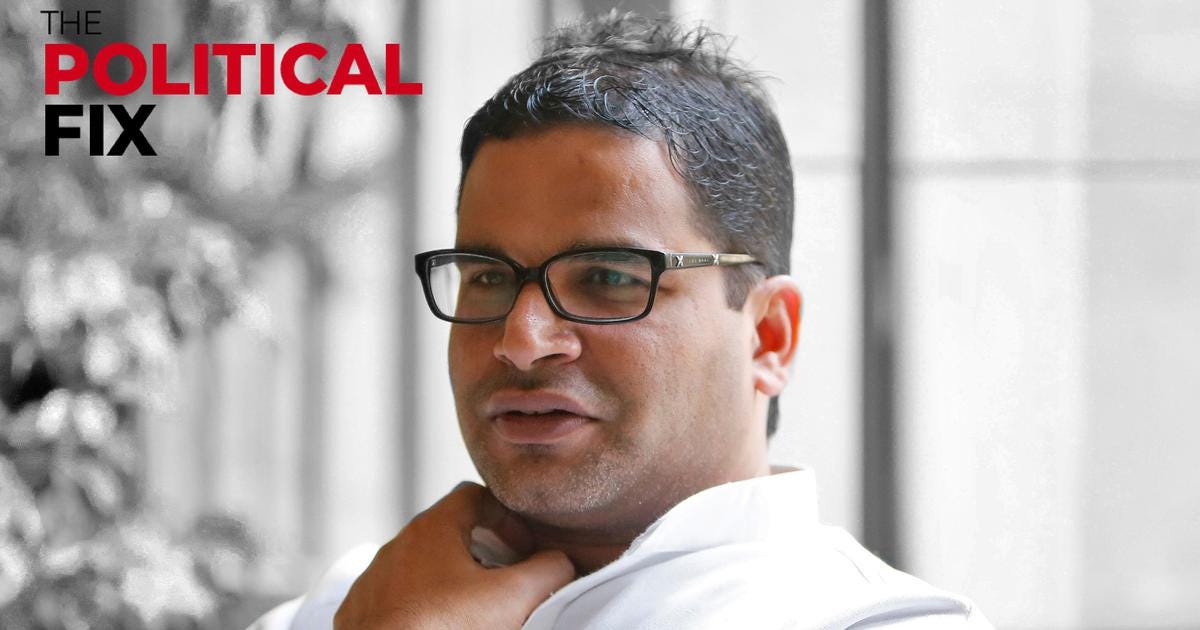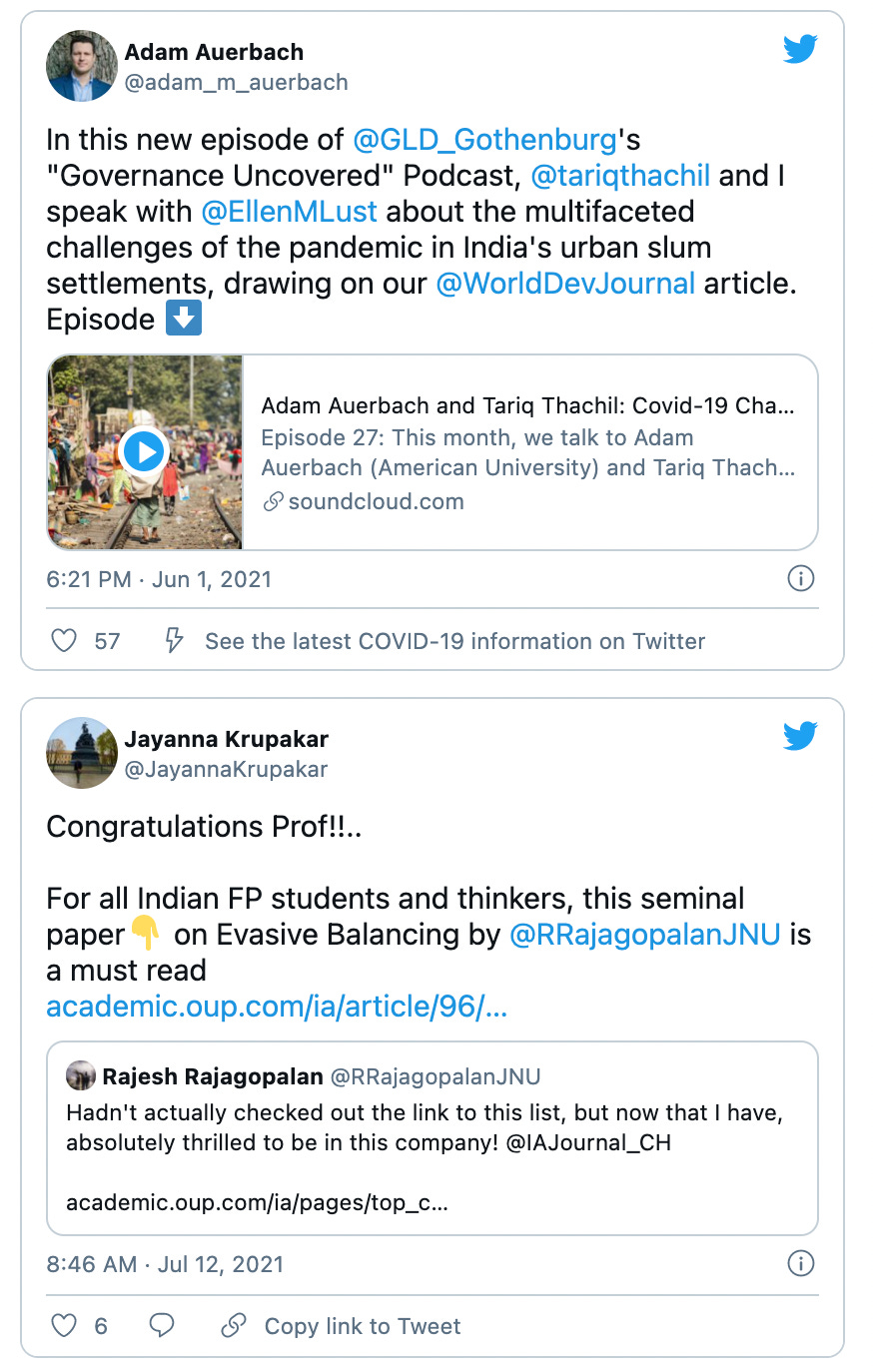The Political Fix: What can Prashant Kishor bring to the Congress – or the anti-Modi Opposition?
Welcome to The Political Fix by Rohan Venkataramakrishnan, a newsletter on Indian politics and policy. To get it in your inbox every week, sign up here.
Reminder: Our small team wants to cover the big issues. That is why we are appealing for contributions to our Ground Reporting Fund. If you’d like to assist our effort, click here.
The Big Story: Peak PK
There are a standard set of questions posed to any effort that seeks to drum up a challenge to Prime Minister Narendra Modi’s electoral juggernaut, at least on the national stage:
Can a group of disparate Opposition parties put aside their differences to actually work together? Do they have a platform that goes beyond the desire to battle anti-Bharatiya Janata Party hegemony? Do they have access to resources to match the BJP’s massive, electoral bond-stuffed war chest? And – most frequently brought up – do they have a face? A leader who can be projected to match up to Modi?
As we approach the mid-way point of Modi’s second term, few of those questions have concrete answers. Yet something has changed.
Modi’s catastrophic mismanagement of the Covid-19 crisis has dented his popularity far more than other policy messes, such as the disastrous demonetisation episode and the broader economic downturn. The last two years have also seen anger against his government converted into popular movements, first in opposition to the Citizenship Act amendments and then in the farmer protests that have brought tens of thousands to agitate in camps on Delhi’s borders for months.
With Lok Sabha elections due in 2024, any effort to answer some of the questions above will have to begin soon. If the reports are accurate (an important “if” because all our information comes from reports right now), one man has a plan for what ought to happen next: Prashant Kishor.
Here’s the Indian Express:
“After holding multiple meetings with NCP supremo Sharad Pawar last month, poll strategist Prashant Kishor on Tuesday met former Congress president Rahul Gandhi and AICC general secretary Priyanka Gandhi Vadra, fueling speculation that these parleys are part of an elaborate spadework to bring opposition parties together to take on the BJP.”
The Hindustan Times had a slightly different take:
“Election strategist Prashant Kishor’s meeting with Rahul Gandhi and Priyanka Gandhi Vadra on Tuesday was to discuss his revival plan for the Congress, people familiar with the matter said on condition of anonymity.
They added that the meeting was a continuation of the previous meetings Kishor has had with the Gandhis, starting with one with president Sonia Gandhi last May, and subsequently with some other top leaders of the Congress, on the same theme, and that it may even involve the election strategist joining the party…
Kishor said the possibility of him joining the party was ‘all speculation’.”
When the meeting was first announced, it was believed to be part of Kishor’s efforts to find a way forward for Punjab Chief Minister Amarinder Singh, who had been caught in an unseemly face-off with Navjot Singh Sidhu, a rival leader who had been demanding to be made Punjab Congress head.
Amarinder Singh is one of the many leaders whom Kishor has worked for after he established himself as India’s top professional election analyst in 2014 with the BJP, with whom he then had a falling out. With Punjab elections due next year, and Kishor tasked yet again with overseeing Amarinder Singh’s campaign as his principal advisor, that explanation would have sufficed.
And indeed, soon after the meeting, it first seemed as if an arrangement had been agreed upon, though this appeared to quickly fall apart, with the two camps back to scheming against the other.
Against this background, what was surprising was the insistence from numerous corners that Kishor’s meeting with the Gandhis went far beyond Punjab. From the Deccan Herald:
“There is a strong buzz that Kishor, who has political ambitions and worked out electoral strategies for many Chief Ministers from Congress and other Opposition parties, could be in for a major role within the Congress or something related to working out coordination between Congress and other Opposition parties.”
Kishor may be well placed to take up the latter role, if only because of his connections with various other leaders.
Since breaking with the BJP after the 2014 elections – reportedly because of pushback from Amit Shah – he has worked with a number of Opposition leaders, from Amarinder Singh to Andhra Pradesh Chief Minister Jagan Mohan Reddy to Delhi Chief Minister Arvind Kejriwal to Tamil Nadu Chief Minister MK Stalin and, most recently West Bengal Chief Minister Mamata Banerjee.
He also explicitly played the role of go-between in the grand alliance forged in Bihar in 2015 to take on the BJP. Kishor even has experience working with Rahul Gandhi directly, in which the Congress tied up with Akhilesh Yadav’s Samajwadi Party in Uttar Pradesh in 2017. However, that effort is his only major electoral failure over the last seven years.
Before speaking to the Gandhis, Kishor had three successive meetings with Nationalist Congress Party leader Sharad Pawar, who would have to play a key role in any national Opposition grouping.
And such a task may also be the most interesting challenge for Kishor, argues Shivam Vij:
“Kishor has already shown he has some ability to turn around difficult situations for opposition parties. He has had enough doubters, but those have been silenced after Bengal. Opposition supporters who used to say Kishor is ideologically suspect, or that he just picks winners, have nothing to say anymore.
That leaves Kishor with only one impossible challenge: national politics. Most people think Narendra Modi is invincible, Amit Shah is the smartest political strategist, and so on. Can Prashant Kishor provide a national challenge to Modi-Shah?”
Joining the Congress and fixing the rot within the party brings more complex demands.
Kishor’s first attempt to go from professional to politician ended in failure. He joined Bihar Chief Minister Nitish Kumar’s Janata Dal (United) in 2018 as vice president. Kumar even claimed that Kishor was is the “future” of the party. Just 15 months later, Kishor was expelled from the JD(U) after publicly objecting to Kumar’s support for the Citizenship Act amendments.
The Congress presents a far bigger challenge as a party in need of reimagining than the JD(U), at least on the national stage.
Questions raised internally by a number of leaders have been left unresolved, even as the party has yet to hold elections for the role of president. Instead, Sonia Gandhi has been interim head since 2019. Major doubts remain about the popular appeal of former president Rahul Gandhi, who went up against Modi in 2014 and 2019. As the Punjab infighting makes evident, even in the few states where the Congress is in power, its internal structures are far from settled.
Kishor may have ideas for how to solve this. As with BJP’s Arun Jaitley in the past, he has a direct line to many journalists around the country to help shape his own image, never mind that of his clients.
But not everyone is a fan of the approach he has taken in the past with the Indian Political Action Committee, his political consultancy group. Kishor and IPAC have often been accused of turning leaders into idols and of not bothering with the ideology that may underpin a party. The sham internal poll held by the organisation to explain why it would be working again with the BJP in 2018 also garnered some attention.
As Ruchi Gupta, former head of the Congress student wing, wrote in May:
“Only strong and well-institutionalised political parties can provide coherence in large and heterogenous electorates by negotiating public opinion on a range of issues to create consensus…
The IPAC model is Prashant Kishor working directly with the leader of the party to take and effect decisions not just on the campaign but also party organisation and even distribution of tickets in a limited manner…
This model undermines the party system… It bypasses the internal feedback mechanism to give primacy to feedback by imported politically agnostic individuals...
[And it] substantially neutralises the ideological component of the party platform by short-circuiting its programmatic agenda to build a campaign around one individual, who personifies not an ideology but the promise of certain benefits from the State.”
More importantly though, both of these potential roles – go-between for an Opposition alliance or Congress entrant tasked with rebuilding the party – would be new ones for Kishor.
His most successful outings have been when a single strong leader throws their weight behind him and his team. Bihar 2015 showed that he could also handle multiple egos, but a national grouping would be of a different magnitude altogether.
While he may enter the Congress with the backing of the Gandhis, each of the three – Sonia, Rahul and Priyanka – have cultivated slightly different camps that do not necessarily work well with each other. This would force Kishor to balance multiple power centres. Moreover, rebuilding a party is nothing like winning a specific campaign.
With Uttar Pradesh elections due next year, the timing to even consider such efforts seems appropriate for both the Congress and the broader Opposition. Whether “PK”, as he is commonly referred to, is able to put forward answers to the questions raised at the start of this piece remains to be seen.
Linking Out
A global investigation by 17 news organisations into illegal cyber surveillance using the Pegasus hacking software found the phone numbers of Indian ministers, opposition politicians, journalists, activists and others on the list of potential targets.
Danish Siddiqui, a Pulitzer-prize winning Indian photojournalist, was killed by the Taliban while covering the current unrest in Afghanistan. Here is some of his remarkable, unforgettable work.
I wrote about how in Tamil Nadu and West Bengal, the BJP has been happy to entertain ideas that it may bifurcate the states for political gain, and what that tells us about the party’s tactics.
Population control suddenly seems to be in vogue again all over India, pushed on by BJP leaders in Uttar Pradesh, Assam and elsewhere. Soutik Biswas and Aparna Alluri break down the debate.
A straightforward story about the percentage of those with criminal cases in Modi’s new Cabinet got mysteriously taken down by the Hindustan Times, reports Supriti David.
Dhanya Rajendran goes back to speak to the 16 Muslim Covid-19 call centre employees whose lives were turned upside down after BJP MP Tejasvi Surya decided to slander and target them, purely because of their religion.
Asim Ali takes stock of politics in UP, with elections due next year.
Can’t make this up
Ramming the point home...
Thanks for reading the Political Fix. Send feedback to rohan@scroll.in.
Support our journalism by contributing to Scroll Ground Reporting Fund.








